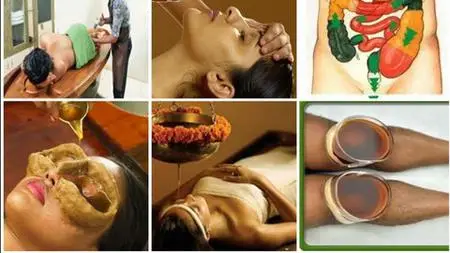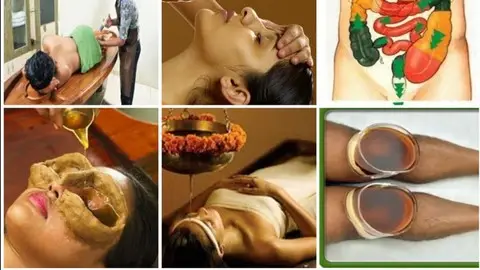Ayurveda Panchkarma - Full Body Detox - Ayurvedic Massage
Last updated 11/2021
MP4 | Video: h264, 1280x720 | Audio: AAC, 44.1 KHz
Language: English | Size: 2.40 GB | Duration: 2h 28m
Last updated 11/2021
MP4 | Video: h264, 1280x720 | Audio: AAC, 44.1 KHz
Language: English | Size: 2.40 GB | Duration: 2h 28m
PRACTICAL AWARENESS IN AYURVEDIC DETOXIFICATION & MASSAGE TECHNIQUES
What you'll learn
You will receive a certificate of completion from Vidya Retreat India.
This program covers the practical training on management of diseases with patient focus.
This program helps to give an idea about the principles of Ayurveda and one can improve the quality of his / her health by practicing the principles mentioned such as diet, routine, exercise etc
This program is oriented to give an insight to the various massage techniques used in Ayurveda. This can be an add-on course to persons who are already working in various health sectors. One can utilize this to improvise his existing knowledge, and to improvise the various techniques to help the needy
Advanced ayurvedic learning for providing health care solutions on a wellness perspective. Students will be eligible to give life style advices and natural remedies for common health issues
A detailed theory of Panchakarma will be covered, including the Poorvakarma (Preparation), Pradhanakarma (Main Procedure) and Paschatkarma (Post procedural convalescence). The preparatory procedures including, various types of Snehana & Swedana therapies including Abhyanga, Choornasweda, Patrapotala Sweda, Njavarakizhi, Pizhichil, Kateevasthy, Nethratharpanam, Lepam, Pichu, etc. This course also includes the five-fold Ayurvedic Detoxification procedures such as Vamana, Virechana, Anuvasana, Niroohavasthy and Nasya. The post Panchakarma convalescence like specific food and lifestyle modification is also a part of this course. This course also covers various aspects of Rasayana- the anti-ageing modalities of Ayurveda.
Requirements
No prior background needed.
Description
Ayurveda is an elegant system of healing, first described around 5,000 years ago in ancient Vedic texts as comprehensive teachings on preserving and maintaining health. The fact that this ancient medicine is still in use today is a testament to the wisdom it holds when it comes to understanding the human potential to achieve a happy and wholesome life.Panchakarma – Rejuvenating DetoxPanchakarma is a Sanskrit word that means “five actions” or “five treatments”. This is a process used to clean the body of toxic materials left by disease, poor nutrition and environmental toxins. Normally the body has the innate ability to efficiently process and remove these waste materials, including the vitiated doshas. However, due to one’s repeated dietary indiscretions, poor exercise patterns, lifestyle, and genetic predisposition, the digestive enzymes, metabolic co-factors, hormones, and agnis which regulate the body’s internal homeostasis become disorganized. This can lead to the accumulation and spread of toxins throughout the physiology resulting in disease. This waste matter is called ama in Ayurveda. Ama is a foul-smelling, sticky, harmful substance that needs to be completely evacuated from the body.Panchakarma will remove the excess doshas and correct imbalances in them as well as eliminate the harmful ama out of your system through the body’s own organs and channels of elimination (colon, sweat glands, lungs, bladder, urinary tract, stomach, intestines, etc). Panchakarma purifies the tissues at a very deep level.It is a very pleasurable experience that is tailored to individual needs and may involve:Daily warm oil massage (abhyanga)Herbal steam therapy (swedana)Lymphatic massageHerbal enemas (basti)Nasal administrations (nasya)Other special treatmentsPanchakarma TreatmentsThe descriptions that follow cover the variety of therapies that may be performed during a Panchakarma series and represent the actual treatments used in this ancient art of life extension. Two Ayurvedic therapists working in synchronicity perform many of them. Two, three, and sometimes four of these therapies are linked together during the course of one day’s treatments.AbhyangaAn individually prepared herbal-oil massage designed to deeply penetrate the skin, relax the mind-body, break up impurities, and stimulate both arterial and lymphatic circulation. It enhances the ability of nutrients to reach starved cells and allows for the removal of stagnant waste. The desired result is a heightened state of awareness that will direct the internal healing system of the body.ShirodharaA warm, gentle and methodic pouring of herbalized oil over the forehead, synchronizing brain waves and profoundly coordinating and calming the mind, body, and spirit.GarshanaA dry lymphatic skin brushing with either a wool or silk glove. This enhances circulation and cleanses the skin so that subsequent oil and herbal treatments can penetrate deeply into freshly cleansed pores.SwedanaAn herbalized steam bath, during which the head and the heart are kept cool (an important difference in Ayurvedic steam treatments) while the body is heated to remove mental, emotional and physical toxins lodged deeply within the tissues. The cool head and heart provide a sense of calm and openness while the therapeutic steam over the entire body can penetrate and cleanse deeply, without overheating and causing stress to the body.UdvartanaA deeply penetrating herbal paste lymphatic massage. This powerful exfoliating treatment will magically restore your natural radiance. It conditions the skin while releasing stagnant lymphatic toxins from the body.Five Senses TherapyThis treatment combines the therapeutic effect of all five senses working in harmony. Sound therapies are specific Vedic hymns and mantras recommended for each imbalance. Touch therapy enlivens specific vital points on the body called marma points. Taste therapy uses certain herbal medicines. Sight uses Ayurvedic color therapy, and smell is accessed with combinations of rare aromatics. The effect harmonizes all of the senses to bring one’s awareness to the source of thought and feeling within the heart.BastiAn herbal enema specially prepared to pull toxins out of the colon. This is the final stage of each daily Panchakarma treatment. The freshly loosened impurities from each day of treatment are flushed out of the body via the effects of the basti. The basti also transports Ayurvedic medicines into the blood and tissues in order to transform the memory of damaged and toxic cells. It is considered one of the most important and most powerful aspects of the Panchakarma treatment.NasyaIndividually prescribed herbs and oil drops, inhaled through the nose, which clear the sinuses of excessive mucus. It is also an important therapy when medicating the central nervous system. This treatment combats the deep dryness that exists at the root of many respiratory and allergic conditions.Shiro-Abhyanga-NasyaA luxurious combination of a deep head/neck/shoulder massage and facial lymphatic massage, followed by deep inhalation of therapeutic aromatic steam, and a nasal and sinus nasya with herbalized nose drops. This popular treatment is an invaluable tool to balancing most head, neck and respiratory disorders.Pinda SwedanaA deep cleansing treatment using rice cooked in milk and herbs that is massaged into the tissues and joints. The treatment is deeply relaxing and rejuvenating as well as powerfully detoxifying.
Overview
Section 1: Introduction
Lecture 1 Introduction
Lecture 2 How To Get Your personal Certificate From Vidya Retreat
Section 2: Basic Principles Of Ayurveda
Lecture 3 Basic Principles Of Ayurveda
Lecture 4 Tri Doshas
Section 3: Ama : Waste Material In The Body
Lecture 5 The Meaning/Nature Of Ama
Section 4: Ayurvedic Approach To A Disease
Lecture 6 Ayurvedic Approach To A Disease
Lecture 7 The six stages of disease development
Section 5: Panchkarma
Lecture 8 Three Stages Of Panchkarma
Lecture 9 Order Of Treatment
Lecture 10 Duration Of Panchkarma Treatment
Lecture 11 Who & When
Lecture 12 General Rules During Treatment
Lecture 13 Benefits Of Panchkarma Treatment
Lecture 14 Diet During Panchkarma Treatment
Section 6: Agni - The Digestive Fire
Lecture 15 Agni - The Digestive Fire
Section 7: Internal Snehana (Abhyantara Snehana)
Lecture 16 Internal Oileation
Lecture 17 Snehana Process
Lecture 18 Snehapana Procedure Fully Explained
Section 8: External Snehana (Bahya Snehana)
Lecture 19 External Oileation
Lecture 20 Abhyangam
Lecture 21 Udvartana
Lecture 22 Samvahana
Lecture 23 Padabhayanga
Lecture 24 Mardana
Lecture 25 Lepa
Lecture 26 Anjana
Lecture 27 Gandusha
Lecture 28 Kaval
Lecture 29 Netra Tarpan
Lecture 30 ABHYANGA or Oil MASSAGE THERAPY Fully Explained
Section 9: Oil Treatments For The Head (Murdha Taila)
Lecture 31 Oil Treatment For Head
Lecture 32 Shirodhara
Lecture 33 Shirobasti
Lecture 34 Shirobasti Procedure Fully Explained
Section 10: Swedana : Therapeutic Sweating Therapy
Lecture 35 Swedana & Its Types
Lecture 36 Pindasweda
Lecture 37 Sweatbox (Bashpa Sweda)
Lecture 38 Swedana in Sauna
Lecture 39 Swedana Procedure Fully Explained
Section 11: Vamana : Therapeutic Vomiting
Lecture 40 Vaman Introduction & Procedure
Lecture 41 Persons UnSuitable For Vaman Procedure
Lecture 42 Persons Suitable For Vaman Procedure
Lecture 43 Vaman Benefits Fully Explained
Section 12: Virechana : Herbal Laxative Therapy
Lecture 44 Virechana Explained
Lecture 45 Medicine For Virechana
Lecture 46 Normal & Abnormal Bouts
Lecture 47 Diet
Lecture 48 Activities To Avoid
Lecture 49 Virechana Procedure Fully Explained
Section 13: Enema
Lecture 50 Enema Procedure Fully Explained
Section 14: Basti : Therapeutic Enema
Lecture 51 Basti
Lecture 52 Indications & Contraindications
Lecture 53 Basti Procedure Detailed Explanation
Lecture 54 Janu Basti
Lecture 55 Netra Basti
Lecture 56 Kati Basti
Section 15: Nasya : Nasal Administration Of Medication
Lecture 57 Nasya
Lecture 58 Nasya Procedure Fully Explained
Section 16: Post-Panchakarma Routine
Lecture 59 Post-Panchakarma Routine Fully Explained
Section 17: Panchkarma Student Handbook
Lecture 60 Panchkarma Student Handbook
AYURVEDIC ENTHUSIASTICS,Alternative Healers,Massage Therapists



